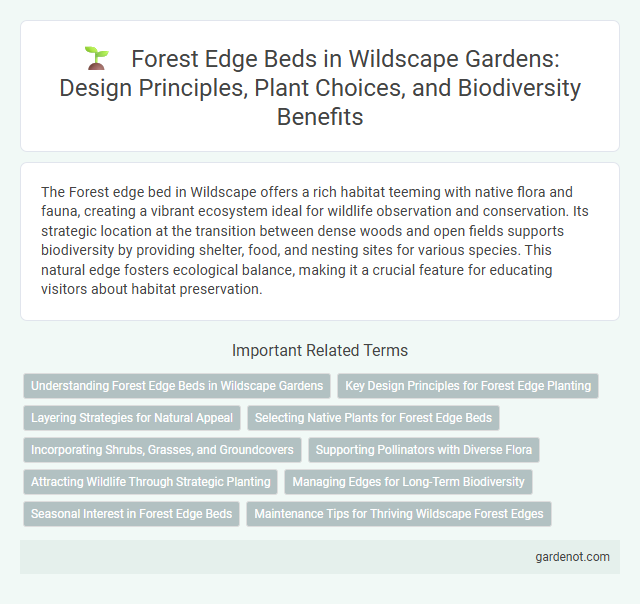The Forest edge bed in Wildscape offers a rich habitat teeming with native flora and fauna, creating a vibrant ecosystem ideal for wildlife observation and conservation. Its strategic location at the transition between dense woods and open fields supports biodiversity by providing shelter, food, and nesting sites for various species. This natural edge fosters ecological balance, making it a crucial feature for educating visitors about habitat preservation.
Understanding Forest Edge Beds in Wildscape Gardens
Forest edge beds in Wildscape gardens mimic natural transitional zones where woodland meets open land, fostering biodiversity by supporting a mix of shade-tolerant and sun-loving plants. These beds are strategically designed to provide habitat complexity, attracting pollinators, birds, and small mammals crucial for ecosystem balance. Incorporating native species such as ferns, wildflowers, and shrubs enhances soil health and promotes ecological resilience within wildscape environments.
Key Design Principles for Forest Edge Planting
Forest edge bed planting emphasizes layering native shrubs, grasses, and wildflowers to create a seamless transition between woodland and meadow habitats. Incorporating species such as hawthorn (Crataegus monogyna), hazel (Corylus avellana), and bluebell (Hyacinthoides non-scripta) supports biodiversity by providing food and shelter for pollinators and small mammals. Strategic spacing and soil preparation enhance root establishment while promoting natural regeneration and resilience against invasive species.
Layering Strategies for Natural Appeal
Forest edge beds thrive through strategic layering, combining ground covers, mid-height shrubs, and taller trees to mimic natural forest margins. Utilizing native plants like ferns, dogwoods, and serviceberries enhances biodiversity while creating depth and texture. This approach promotes seasonal interest and supports local wildlife habitats, blending seamlessly with the surrounding landscape.
Selecting Native Plants for Forest Edge Beds
Choosing native plants for forest edge beds enhances biodiversity and supports local wildlife by providing natural food sources and shelter. Species such as serviceberry, spicebush, and wild columbine thrive in transitional zones, creating a layered habitat that buffers forest interiors and open areas. Native plants adapted to local soil and climate conditions ensure resilience and lower maintenance for sustainable forest edge gardening.
Incorporating Shrubs, Grasses, and Groundcovers
The Forest Edge Bed thrives by incorporating a diverse mix of shrubs, grasses, and groundcovers that create layered habitats for wildlife. Native shrubs like serviceberry and spicebush provide food and shelter, while ornamental grasses such as little bluestem add texture and movement. Groundcovers including wild ginger and foamflower suppress weeds, retain moisture, and enhance soil health, supporting a resilient and vibrant wildscape ecosystem.
Supporting Pollinators with Diverse Flora
The Forest edge bed is designed to support pollinators by incorporating a diverse array of native flowering plants that bloom throughout the seasons, providing essential nectar and pollen sources. This habitat diversity attracts bees, butterflies, and other beneficial insects critical for maintaining ecological balance. Planting a mix of wildflowers, shrubs, and grasses creates a rich ecosystem that enhances pollination and promotes biodiversity within the Wildscape environment.
Attracting Wildlife Through Strategic Planting
Strategic planting around Forest Edge beds enhances biodiversity by providing shelter, food, and nesting sites for local wildlife such as birds, bees, and butterflies. Incorporating native trees, shrubs, and wildflowers creates habitat corridors, boosting pollinator activity and supporting species like woodpeckers and hedgehogs. This approach fosters a thriving ecosystem, increasing wildlife sightings and promoting natural pest control.
Managing Edges for Long-Term Biodiversity
Managing forest edges by maintaining a gradual transition between woodland and open habitats enhances long-term biodiversity by supporting diverse species adapted to edge environments. Techniques such as selective thinning, controlled burns, and native planting promote varied microhabitats that increase species richness and ecological resilience. Effective edge management in wildscapes mitigates habitat fragmentation impacts, facilitating wildlife corridors and sustaining ecosystem services.
Seasonal Interest in Forest Edge Beds
Forest edge beds offer seasonal interest through a dynamic mix of native shrubs, wildflowers, and grasses that change color and texture throughout the year. Spring brings vibrant blooms like trillium and bleeding hearts, while summer showcases lush foliage and pollinator-friendly blooms such as coneflowers and goldenrods. Autumn highlights include rich hues of sumac and dogwood leaves, providing a visually appealing transition to winter's bare branches and evergreen accents.
Maintenance Tips for Thriving Wildscape Forest Edges
Forest edge beds in wildscapes thrive when regularly mulched to retain moisture and suppress weeds, promoting healthy root development. Pruning damaged or invasive plants enhances air circulation and reduces competition for nutrients, vital for edge biodiversity. Incorporating native species and monitoring soil pH ensures a balanced ecosystem, supporting diverse wildlife habitats.
Forest edge bed Infographic

 gardenot.com
gardenot.com